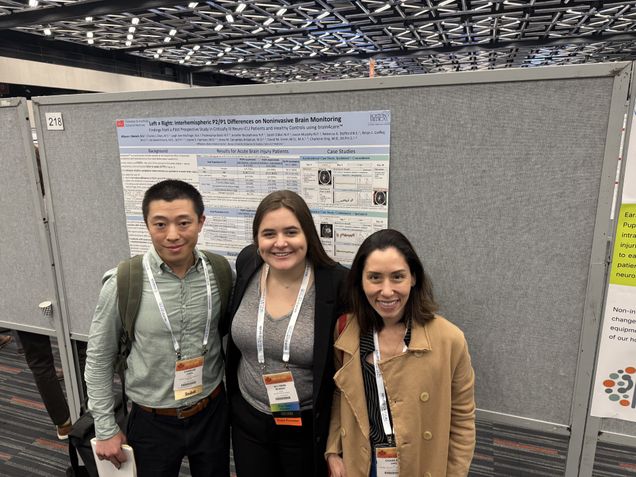Student Spotlight: Charles Chen ’28
 Congratulations to Charles Chen ’28, a current M2 student who recently presented at the Neurocritical Care Society Conference! Under the mentorship of Dr. Charlene Ong, Charles presented his research project, “Quantitative Pupillometry Signatures and Associations with Different Phenotypes of Traumatic Brain Injury” (first author). Charles notes “it is difficult to predict the prognosis of patients with traumatic brain injury (TBI), though estimates of prognosis are very important for clinical decision making in the neuro ICU setting. Quantitative pupillometry has shown promise for outcome stratification in TBI and as a predictor of neurologic deterioration in other acute brain injuries. However, because TBI can present with a variety of intracranial injuries.” Charles and Dr. Ong’s lab’s aim is to determine which injury types and AI-determined lesion characteristics are associated with lower pupil reactivity and determine a set of clinical and objective characteristics that delineate various phenotypes of TBI, which will allow for better understanding of clinical presentations and outcomes.
Congratulations to Charles Chen ’28, a current M2 student who recently presented at the Neurocritical Care Society Conference! Under the mentorship of Dr. Charlene Ong, Charles presented his research project, “Quantitative Pupillometry Signatures and Associations with Different Phenotypes of Traumatic Brain Injury” (first author). Charles notes “it is difficult to predict the prognosis of patients with traumatic brain injury (TBI), though estimates of prognosis are very important for clinical decision making in the neuro ICU setting. Quantitative pupillometry has shown promise for outcome stratification in TBI and as a predictor of neurologic deterioration in other acute brain injuries. However, because TBI can present with a variety of intracranial injuries.” Charles and Dr. Ong’s lab’s aim is to determine which injury types and AI-determined lesion characteristics are associated with lower pupil reactivity and determine a set of clinical and objective characteristics that delineate various phenotypes of TBI, which will allow for better understanding of clinical presentations and outcomes.
Charles was interested in exploring an area where there are still many unclear answers. Also, as an engineer prior to medical school, Charles was interested in examining how he could use his prior skills to contribute to his lab and to the field. His interest in this study stems from the fact that there still remains a wide knowledge frontier in neurology. This is particularly true in the neuro ICU setting, as well as in certain conditions such as TBI. Charles’ study is one small example of a larger pattern of the increased use of AI and other data analytics modalities to study and progress the field of neurocritical care.
When Charles attended the Neurocritical Care Society conference, he was struck by how there was a theme that came up time and time again with TBI research – a significant challenge of TBI research is that this is an incredibly heterogeneous condition. There is a broad swathe of injury mechanisms and injury types, as well as high variation in clinical presentations and outcomes in TBI, which makes studies difficult. He also learned that there have been huge strides in AI, big data and precision medicine techniques in neuro ICU research. One way to conceptualize his study is that it aims to use these strides in analytics techniques in order to take this very heterogenous population of patients with TBI, and to break it down into smaller, more homogeneous phenotypes.
 Charles gives special thanks goes to his primary mentor, Dr. Ong (pictured on the right). From providing thoughts and background on the study, Dr. Ong pushed Charles to consider various grant applications and abstract submissions, or general professional and personal thoughts. He notes “she is a phenomenal mentor in every sense of the word, and in multiple dimensions.”
Charles gives special thanks goes to his primary mentor, Dr. Ong (pictured on the right). From providing thoughts and background on the study, Dr. Ong pushed Charles to consider various grant applications and abstract submissions, or general professional and personal thoughts. He notes “she is a phenomenal mentor in every sense of the word, and in multiple dimensions.”
He would also like to thank Allyson Reinert and Leigh Ann Mallinger, who are 2 incredible research assistants in the Ong Lab, and who have their hands in just about everything that runs in the lab. Dr. Samuel Snider (at Brigham) provided in-depth feedback on image segmentation techniques using AI. Dr. Shariq Mohammed from the biostatistics department had excellent insight into the statistical techniques, as well as thoughts on next steps with the imaging analysis. Dr. Mohamad Abdalkader is a phenomenal interventional neuroradiologist with great feedback into how to best interpret the imaging modalities and results.
More reflections from Charles he states, “I had never done any research prior to joining Dr. Ong’s lab last year. At that time, the idea of me ever being capable of presenting a poster at a national conference would have felt ludicrous. Medical training is a continual process of running into the limits of what you think is possible and expanding them. I’ve enjoyed being able to learn and to contribute to the team in a collaborative fashion, and I continually surprise myself at what I have learned and accomplished.”